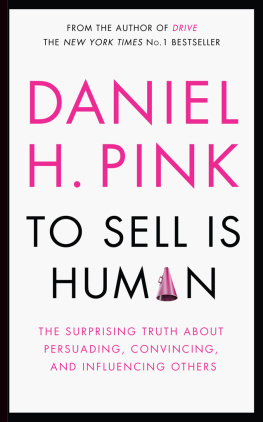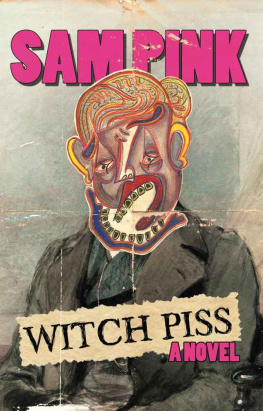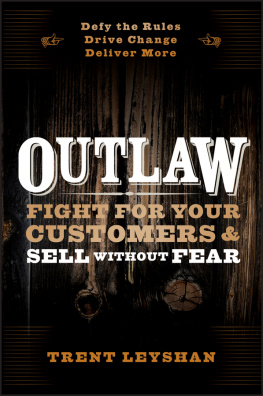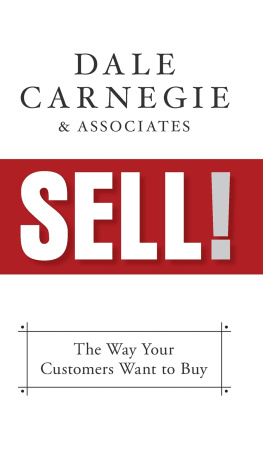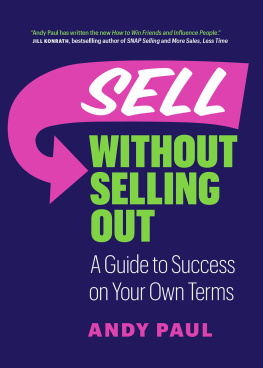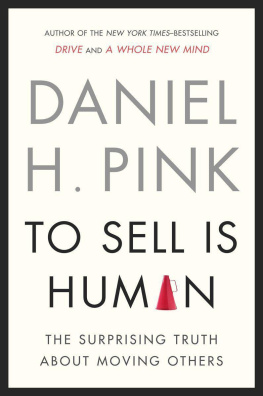INTRODUCTION
Overview
In To Sell Is Human: The Surprising Truth About Moving Others, author Daniel H. Pink draws on social science to redefine the rules of selling, offering counterintuitive insights on how and why the art of the deal has changed. Pink contends that the line between seller and customer has blurred, and everyone, no matter the occupation, spends most of his or her time selling somethingan idea, an agenda, an itemto somebody.
Selling... is more urgent, more important, and, in its own sweet way, more beautiful than we realize. The ability to move others to exchange what they have for what we have is crucial to our survival and happiness. It has helped our species evolve, lifted our living standards, and enhanced our daily lives. The capacity to sell isnt some unnatural adaptation to the merciless world of commerce.... Selling is fundamentally human.
Daniel H. Pink, To Sell Is Human
As technology reshapes how people work, buyers, who were once dependent upon salespeople for information, are often more informed than the salesperson. Even in a world where bargaining power has achieved parity, Pink argues that sales is not dead, but exists in a revised form he calls non-sales selling, the act of moving people to do something other than reach for their wallets.
With the new economy relying so heavily on non-sales selling, it is critical to be successful at it, which requires learning the new rules for moving others.
In Part One: Rebirth of a Salesman (Chapters 13), Pink argues for a broad rethinking of sales, laying the groundwork for a necessary shift in how sales is perceived in the second decade of the twenty-first century. In Part Two: How to Be (Chapters 46), Pink teaches readers the three qualities most valuable in todays sales and non-salesselling environment. According to Pink, the sales trade adage Always Be Closing has been replaced with the new ABCsAttunement, Buoyancy, and Clarity. In Part Three: What to Do (Chapters 79), Pink concludes with three integral skills to hone in order to more effectively move others: pitch, improvise, and serve.
In To Sell Is Human, Pinks objective is not only to teach readers how to become more effective sellers, but also to shed new light on the act of selling, an act, he says, that is fundamentally human.
About the Author
Daniel H. Pink is an acclaimed expert on the art and science of motivation. His two New York Times best sellers, Drive: The Surprising Truth About What Motivates Us and A Whole New Mind: Why Right-Brainers Will Rule the Future, have sold more than a million copies and have been translated into thirty-three languages. Pinks 2009 TED talk on the science of motivation revolutionized long-held perceptions about intuitive thinking; it is one of the top twenty most-viewed TED videos of all time. In 2011, Thinkers50 named Pink one of the fifty most influential management thinkers in the world. His articles have appeared in the New York Times, the Harvard Business Review, Fast Company, and Wired. A graduate of Yale Law School, Pink served as an aide to Secretary of Labor Robert Reich, and later as chief speechwriter for Vice President Al Gore. Pink lives in Washington, DC.
How the Book Came About
Following the thread of his previous business bestsellers, Daniel H. Pink approaches the history and practice of sales from the context of our rapidly changing culture and workplace in his 2012 publication, To Sell Is Human. In the introduction, Pink says the idea for the book was born out of a review of his own work calendar, noticing that most of his time was spent trying to persuade people to do something or to part with resources. I am a salesman, Pink writes. But most of what I do doesnt directly make a cash register ring. Neither does much of what others do in sales, Pink concludes. Sales have been redefined by technology, shifting industry, education, and emerging fields, and this book gives a snapshot of how the changing tide of traditional sales can be applied to non-sales sellingand vice versaand what skills are required to do so successfully.

WERE ALL IN SALES NOW
Overview
In this age of technology, the traditional salesperson, personified by the Fuller Brush Man or the Avon Lady of yesteryear, is superfluous. Keystrokes and smartphones have rendered salespeople irrelevant, yet sales remains the second-largest occupational category. While one in nine workers performs traditional sales, the other eight perform non-sales sellingpersuading, influencing, and convincing others in ways that dont involve anyone making a purchaseand they dont even know it. With this new data at hand, Pink concludes that there has not been a death of a salesman but a rebirth of an entire generation of sellers. Because the salesperson is us, says Pink.
Chapter Summary
In Chapter 1, Pink introduces readers to the very last Fuller Brush Man in America, seventy-five-year-old Norman Hall, who was still selling door-to-door in the business district of San Francisco at the time of the books publication. The iconic Fuller Brush Man is a relic of the days when door-to-door peddlers played a viable role in the countrys sales force. Fuller Brush at its heyday in the 1960s was the equivalent of a billion-dollar business, but as the anecdote of Norman Hall illustrates, the market for door-to-door sales is gone, and online research and purchasing make middleman salespeople unnecessary. Yet although the Fuller Brush Man, with his dapper bow tie and satchel of goods, belongs to a past era, the author argues that the only thing obsolete about sales in todays society is an antiquated definition of selling.
To support this argument, Pink identifies a new sector of sales dominating the second decade of the twenty-first century, which he calls non-sales selling. Conventionally speaking, producing and consuming have been viewed as the most critical behaviors in economics, but Pink says much of what people set out to do these days is to move othersto influence or persuade themto vote, invest, pay attention, or even date. From Facebook and Twitter to KickStart campaigns and Match.com to board meetings and budget proposals, non-sales selling consumes the personal and work lives of the majority of the population.
The Rise of Non-Sales Selling
Non-sales selling has escaped detection in formal surveys by the government. Although everyone from doctors and coaches to authors and craftspeople attempt to persuade others as part of their work, the statistical records of the US Bureau of Labor do not track non-sales selling. According to Pink, the work of moving others does not appear in federal labor statistics because the kinds of questions used in the surveys of workers are not the right kinds of questions. By conducting his own survey of about seven thousand US workers called What Do You Do at Work? Pink, assisted by an analytics group, found that across a professional spectrum, people working full time spend roughly twenty-four out of every sixty minutes involved in persuasion that does not result in a purchase. Further, the survey revealed that people considered this persuasive effort critical to the success of their worksomething most workers believe they should be doing more of.
In this sense, Pink suggests, everyone is in sales even without full awarenessone in nine Americans works in sales, but the new data reveals that so do the other eight in nine. So the Fuller Brush Man is alive as new sales memes are sought and set. With the majority of Americans livelihood dependent on the ability to move others, and do it well, its time for a fresh look at the art and science of selling, beginning with answering the question: How did so many people get into the moving business?
Next page
![Pink To sell is human-- in 30 minutes: the expert guide to Daniel H. Pinks [critically acclaimed book]](/uploads/posts/book/227093/thumbs/pink-to-sell-is-human-in-30-minutes-the-expert.jpg)
